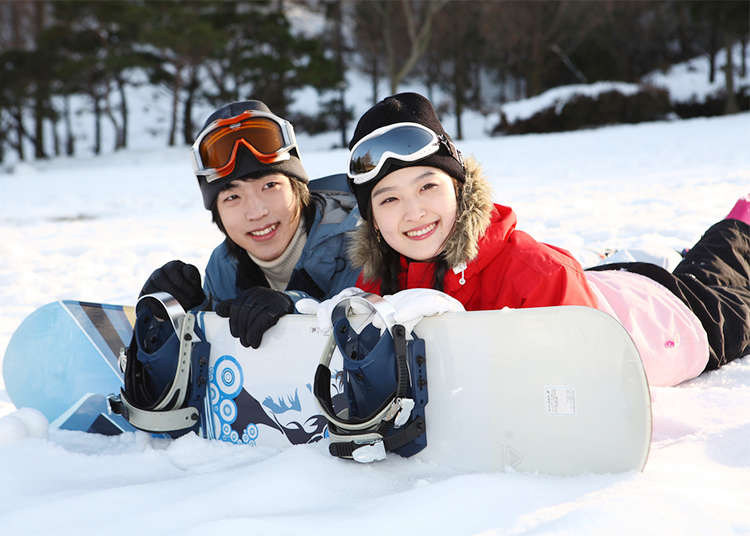
So you’ve heard of how amazing Japan’s winter is but never stood on skis or a snowboard in your life?
That’s alright – skiing in Japan for beginners is great. Many of the country’s winter sports resorts offer everything you need as a ski and snowboard beginner! Your lack of experience won’t stand in the way of having an amazing winter vacation in Japan.
Here is everything you’ll want to know before hitting the snow, from how to choose where to go-to equipment and life on the piste. (“Piste” is the word for a ski run. There, you learned your first snow-related term!)
Why Ski in Japan?
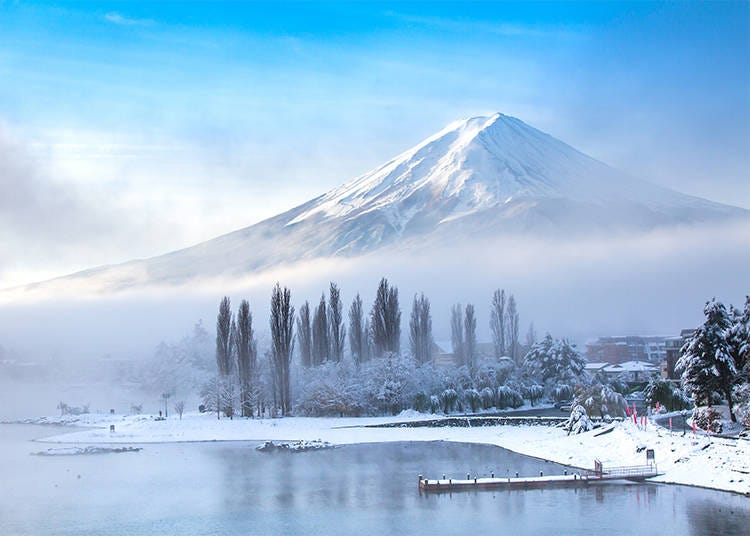
You might be surprised but Japan is an excellent choice to learn how to ski or snowboard. One big reason for that is the climate and topography of the country. Japan’s mountains aren’t all tall as famous ski areas in Europe and North America, which means that many offer gentle terrain and thus equally gentle slopes.
Because of this, Japan’s mountains also boast amazing powder snow. The snowfall doesn’t stem from the altitude but from the climate. On top of that, the snow is also relatively dry and hence much less icy, making falling – and you’ll fall a lot – much less painful.
Another reason is cost. At first, it seems expensive but when compared to winter sports areas around the world, Japan’s resorts are surprisingly low when it comes to prices. And where else could you soak your body in a natural hot spring after a long day on the piste?
How to Choose the Right Ski Resort in Japan
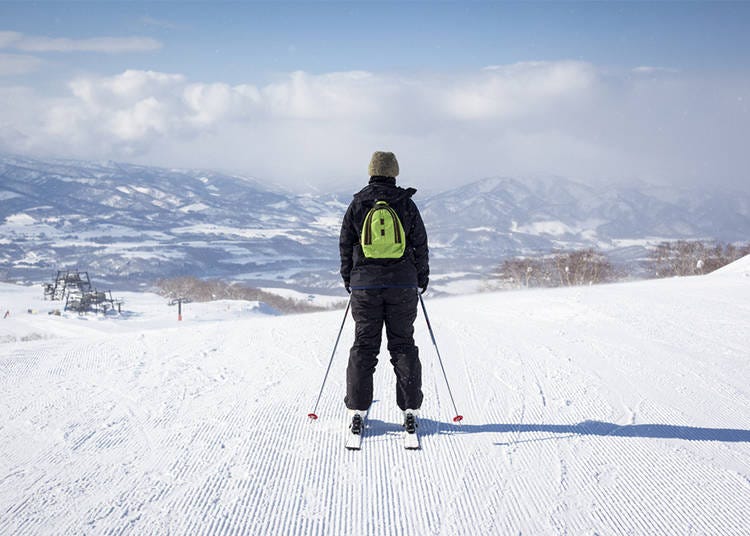
When skiing in Japan as a beginner, you want a place that doesn’t only offer gear rental but also lessons to show you the ropes. On top of that, it is important to check if a place offers enough beginner-friendly pistes – if there are merely one or two, you might get bored after a few days and try your luck on more advanced pistes without the proper skill.
As explained above, beginner pistes are plentiful in Japan. Throughout the country, they’re marked as green, while the beginner-intermediate level is indicated as blue. When going through resorts, make sure to look at the course maps and confirm how many green and blue pistes are available.
Even if you’re with a skilled friend or family member, we highly recommend opting for a ski school or lessons instead of being taught privately. This way, everyone can enjoy skiing and snowboarding at their level without compromise. A lot of resorts throughout Japan have started offering lessons in English and other languages, so this should be one of your main criteria.
Recommended resorts/areas for beginners:
Hokkaido
- Niseko United
- Rusutsu Resort
- Hoshino Resorts Tomamu
Around Tokyo
- Nozawa Onsen
- Yuzawa (especially Mt. Naeba)
- Hakuba
- Minakawa
Skiing in Japan for beginners: What clothes to bring
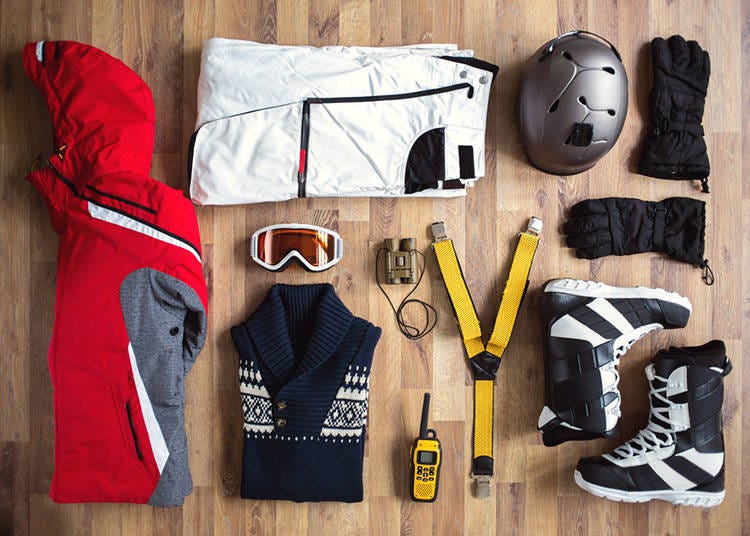
Before worrying about skis and a snowboard, you need to think about the proper clothing. If you’re not sure whether winter sports are up your alley, you don’t need to spend a fortune on a full set of ski wear. The majority of resorts offer rental even for clothes, while even certain outdoor shops in Tokyo offer such a service. Here is how a full set of ski wear looks, separated into what you can rent and what you can’t (or shouldn’t rent.)
Rental:
Helmet
Especially as a beginner, a helmet is an absolute must. It protects your head when you fall, and as a beginner, you’ll fall a lot – it’s part of the experience! They need to fit properly, too, so the best option is to consult with knowledgeable staff at a resort’s or shop’s rental counter.
Goggles
Why goggles? Because they’ll protect you from cold wind and snow blowing in your face and shield your eyes from the UV rays. Sunglasses are not an adequate replacement.
Gloves
Regular gloves that you’d wear on a stroll during winter will get you ice-cold fingers on the piste in no time. Your winter sports gloves need to be water-resistant to fend off the snow.
Jacket
The jacket, too, needs to be waterproof and should have a loose fit, as you’ll be wearing at least one more layer of clothes underneath.
Pants
For beginners, we highly recommend waterproof and insulated pants, as you’ll be falling in the snow quite a lot. No one likes skiing with a cold bottom.
Your Own:
Base layer
The base layer is what is in contact with your skin, and like with any sport, you’ll likely sweat. Choose synthetic fiber or merino wool but absolutely stay away from cotton because cotton is infamous for not drying properly.
Mid layer
The mid-layer is worn between the base layer and ski jacket and pants and can be optional. Fleece or nylon is usually a good choice to provide extra warmth and insulation.
Socks
Your socks need to be thick because your toes will get frosty cold otherwise. Special socks designed to fit ski boots are available in every outdoor store, and we highly recommend getting a few pairs of those.
Doing Ski Equipment Rentals in Japan
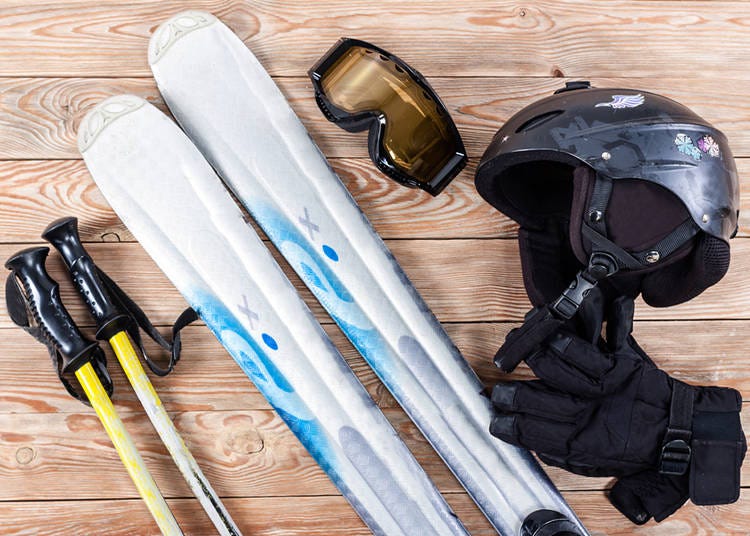
Ski
Ski equipment consists of skis, poles, and boots. The common way is to rent them in a bundle. As a total beginner, you won’t have to worry about the details too much – at resorts and specialized shops, the staff will choose the right ski and pole length together with you, as well as the ski boots.
The boots are crucial to your experience. Ski boots will never feel as wonderfully comfortable as regular shoes, but they shouldn’t hurt you or be too tight either. To make sure that the size and shape fit your feet, wear thick socks when trying on the boots and perform a couple of actions. Stomp on the ground, walk up and down, jump, and run to ensure that nothing hurts.
Once you found the right equipment, ask the staff to set up the binders on your skis to match your boots and train how to put them on and off a couple of times.
Snowboard
Like skis, it’s best to rent snowboard and boots in a set. The bindings for snowboards work differently, though, and we recommend setting the position that is recommended by the manufacturer. Ask the staff for help if you aren’t sure.
Then there’s the angle, referring to the angle at which the bindings are attached. It determines where your toes are pointing, basically. This can be changed by rotating the binding disc plate.
There are a couple of other settings that you’ll want to adjust once you’ve found a bit of security on the board and start to explore your riding skill, but those are best discussed with either staff or a trainer.
One of the smallest but most important things of the snowboard is the leash. It connects the binding with your boot and keeps the snowboard from sliding off on its own when you fall. Most Japanese resorts require you to have a leash attached to use their pistes.
Rental Procedure
At most places, you’ll have to write your height, Japanese shoe size, and other details on a paper that is submitted to the rental staff, so make sure that you got this information down. A form of ID will be required as well, such as your passport, driver’s license, and so on.
Ski & Snowboarding Lessons in Japan
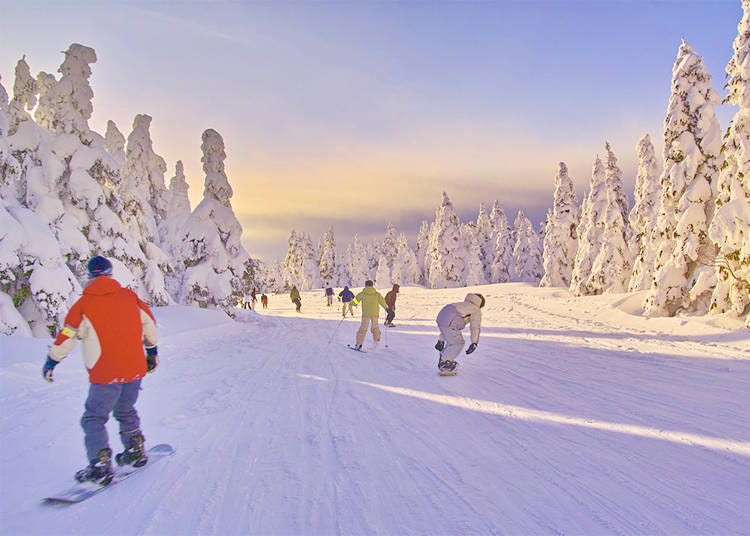
With clothes and gear all set up, it’s time to hit the piste! As explained earlier, we highly recommend booking lessons at your resort of choice. Professional instructors will teach you the basics of moving on skis and snowboard while also choosing appropriate terrain.
Lessons vary greatly in duration, such as half-day, full-day, or multiple days, and are typically group lessons. The price is also entirely dependent on the resort – some places offer packages and discounts, so keep an eye open.
Color Codes Used on Pistes in Japan
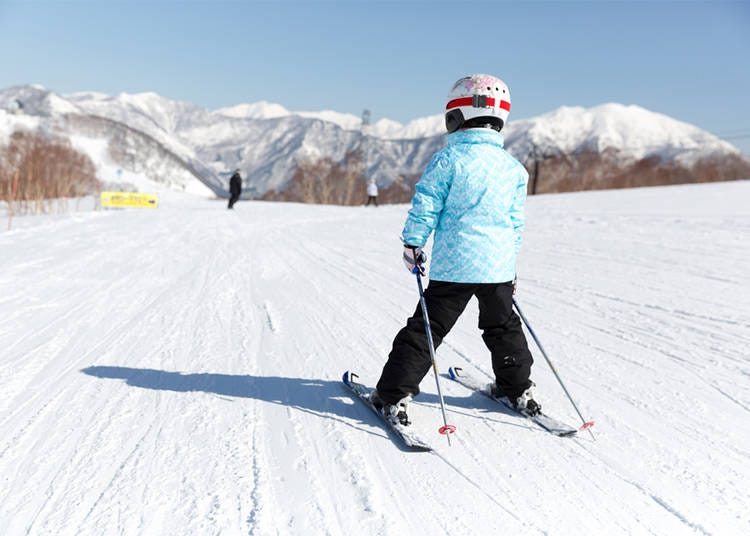
As briefly explained earlier, pistes in Japan are color-coded. It is a similar system to the one in place in Europe but different from North America. In general, pistes can be groomed or ungroomed, meaning that they’re maintained with tracked vehicles called snow cats.
They turn the piste into even terrain and remove moguls (bumps). Ungroomed pistes, on the other hand, will have you skiing over freshly fallen snow or snow shaped by other skiers – beginners should stay clear of them, if possible.
Let’s take a look at color coding:
Green
The beginner piste. A lot of them are on the base of a mountain but some can be higher up. Their gentle terrain offers beginners the freedom to get comfortable with their equipment and the movement without having to be scared of all too sudden acceleration and a lack of control.
Blue
Only some resorts in Japan have blue pistes. They mark a level between beginner and intermediate and are a good choice once you’re starting to get a bit bored with green.
Red
Intermediate pistes are marked with a red color. The majority of all slopes in Japan are red and thus are the most common pistes found at most resorts.
Black
The expert piste. They’re steep and difficult, stay clear of them for now.
How to Ride the Lifts in Japan
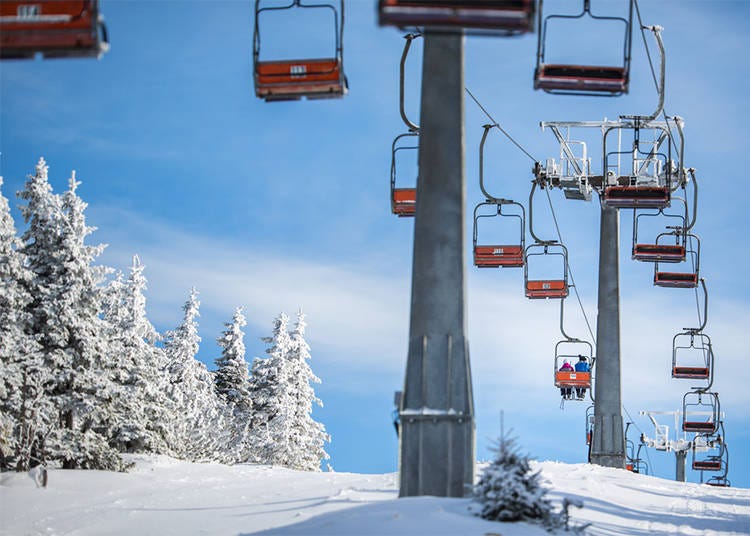
As you might have guessed, you don’t need to climb the mountain every time you want to ski or board down. Ski lifts transport you up comfortably and safely!
Lift tickets can be bought for single uses, one day, several days, and in many other options. Their price varies by resort. Usually, you’ll get one for one or multiple days with your resort booking. You need to constantly carry it with you while on the piste, but most jackets have a special ticket pocket or some such. If not, it doesn’t hurt to bring a pouch that you can easily wear under your jacket or put in a pocket.
But how to ride a lift? It depends on the type of lift available, with chairlifts being one of the most common options. Usually, you step forward as the lift approaches from behind, and you sit down just when it’s under you. If there’s a safety bar, pull it down and enjoy the ride.
There are a couple of things to keep in mind. Don’t dangle your legs, as your ski’s bindings might come loose. Don’t shake, as that could lead to some of the equipment disconnecting. And even if you drop something, do not jump off. The areas under the lift aren’t pistes and not maintained, making it hard for you to move and rescuers to get to you.
If you’re skiing in Japan with kids, help them move forward if need be and get in position. Keep an eye out for the lift approaching from behind and help your child on with both hands. Help again when it is time to get off, first by helping them on the ground, then to get out of the way.
Skiing in Japan for Beginners: Do's and Don’ts
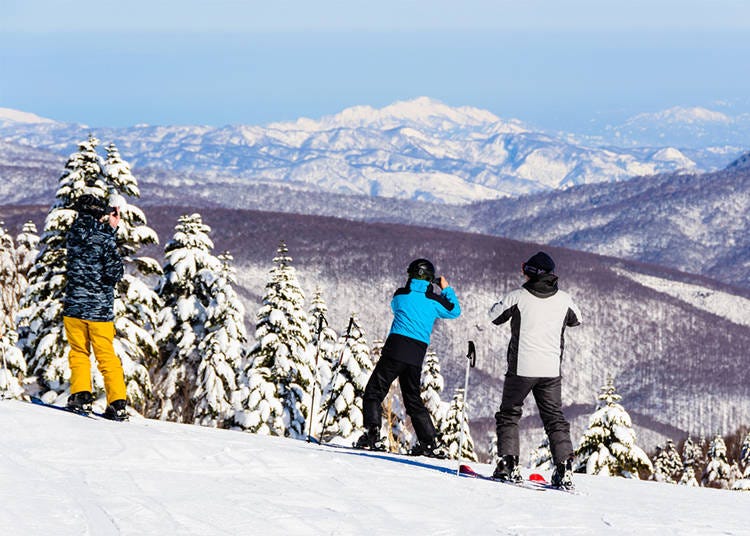
We almost got all the basics covered to have you prepped for your first winter sports adventure. One last thing to keeping mind is the do’s and don’ts of skiing and snowboarding in Japan – although some things are applicable worldwide.
・Don't sit down mid-run
Especially as a beginner, taking a break after a fall halfway down the piste can seem tempting. However, that is fairly dangerous as you’re risking people coming from above running into you. The angle of the slope changes, so sitting down, you’re extremely hard to see. That can lead to injuries for all people involved.
・Don’t walk on the piste
For the same reason, taking off your gear and walking is a no-go. On top of the safety hazard comes the fact that your boots will leave holes in the maintained piste which can cause other skiers and snowboarders to fall and injure themselves.
If you still have to walk (because you want to skip part of the piste to practice your skills, for example), walk on either side of the course.
・Be aware of your surroundings
As many people use pistes, you need to be aware of your surroundings. That means that before starting to move, take a look behind you if there isn’t someone coming your way. The same goes for looking straight ahead – if you see someone being slower than you, check behind you if it’s safe to go past.
・Use equipment as it is intended
What does that mean, you might ask? Using your snowboard as a sled, for example. You will be able to control neither speed nor direction, making your movement unpredictable and thus dangerous for yourself and others.
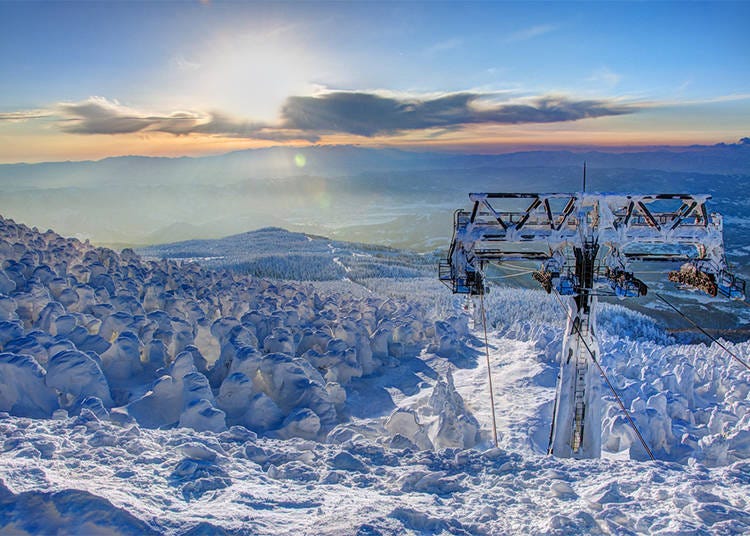
Skiing and snowboarding in Japan is a unique experience that combines the fun of winter sports with savoring traditional hot spring culture. With the basics covered, check out our other guides on the topic!
Copy & Photos: Chiho Kuriyama. Editing by Pamela Drobig and Timothy Sullivan.
▼Early-bird lift tickets are recommended for winter skiing in Japan▼
- Category
*Prices and options mentioned are subject to change.
*Unless stated otherwise, all prices include tax.
Limited time offer: 10% discount coupons available now!
Recommended places for you
-

Jukuseiniku-to Namamottsuarera Nikubaru Italian Nikutaria Sannomiya
Izakaya
Kobe, Sannomiya, Kitano
-
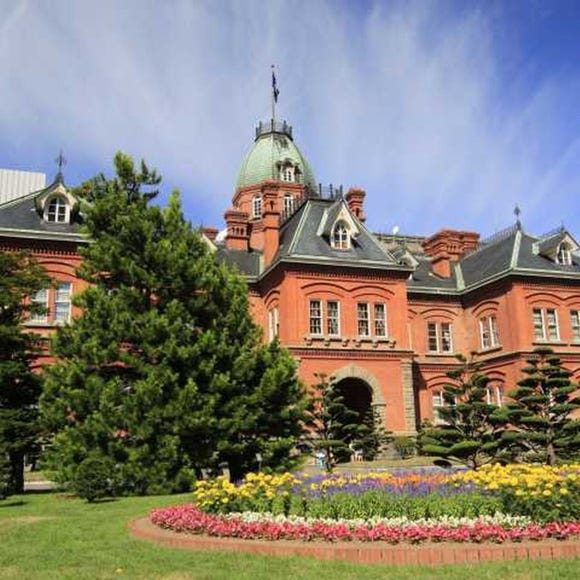
Former Hokkaido Government Office Building (Red Brick Office)
Other Historic Sites
Sapporo / Chitose
-
Goods

Yoshida Gennojo-Roho Kyoto Buddhist Altars
Gift Shops
Nijo Castle, Kyoto Imperial Palace
-
Appealing
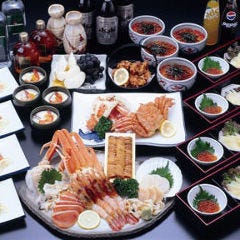
Rukku and Uohei
Izakaya
Sapporo / Chitose
-
Menu
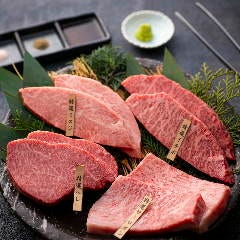
ISHIDAYA Hanare
Yakiniku
Kobe, Sannomiya, Kitano
-
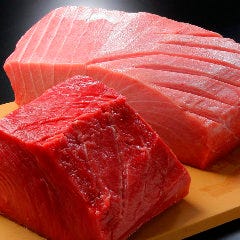
Kamesushi Sohonten
Sushi
Umeda, Osaka Station, Kitashinchi
-

Discover Osaka Station City: A Journey Through Its Most Fascinating Spots
-

15 Must-Try Sushi Restaurants in Tokyo (+5 Trending Areas to Explore for Foodies)
-

Where to Eat in Shibuya: 14 Must-Try Restaurants for Yakiniku, Sushi, Izakayas, Cafes and More
-

Where to Eat in Yokohama: 10 Must-Try Restaurants for Yakiniku, Izakayas, Unique Dining & More
-

12 Unique & Fun Tokyo Food Tours to Enjoy in 2024
-

Professional Photos Even Beginners Can Shoot! 10 Tips for Taking Stunning Cherry Blossom Photos
-
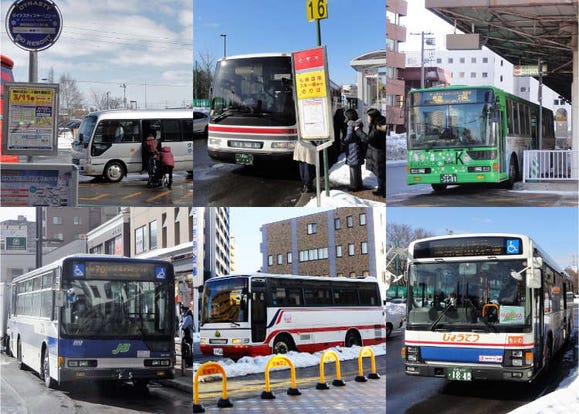
How to Get to Sapporo's Top Ski Resorts & Snowy Areas by Train and Bus
-
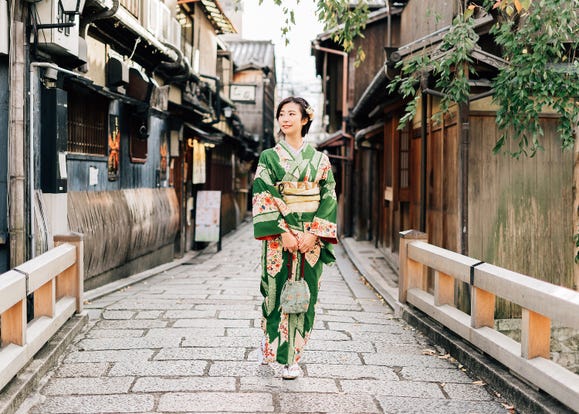
38 Best Things to Do in Kyoto: See, Eat, and Shop Your Way Through Japan's Cultural Capital
-
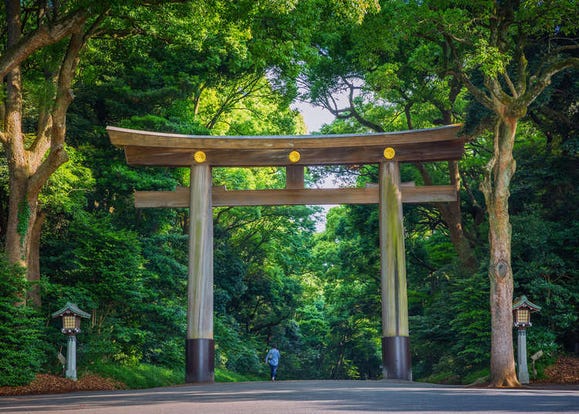
Meiji Shrine (Meiji Jingu): Exploring the Sacred Sanctuary of Peace in Bustling Tokyo
-
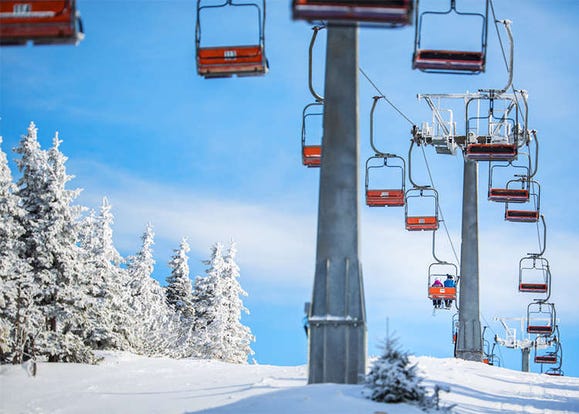
Japan Lift Passes for Beginners: All About Getting Your Lift Ticket
-

Niseko Ski Resorts: See Why the World is Wild for 'Japow'! (Guide/Hotels/Tickets)
-
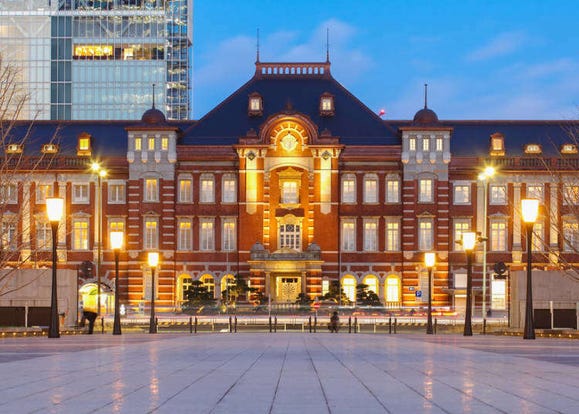
Exploring Tokyo: 3 Must-Visit Spots around Tokyo Station
- #best sushi japan
- #what to do in odaiba
- #what to bring to japan
- #new years in tokyo
- #best ramen japan
- #what to buy in ameyoko
- #japanese nail trends
- #things to do japan
- #onsen tattoo friendly tokyo
- #daiso
- #best coffee japan
- #best japanese soft drinks
- #best yakiniku japan
- #japanese fashion culture
- #japanese convenience store snacks












